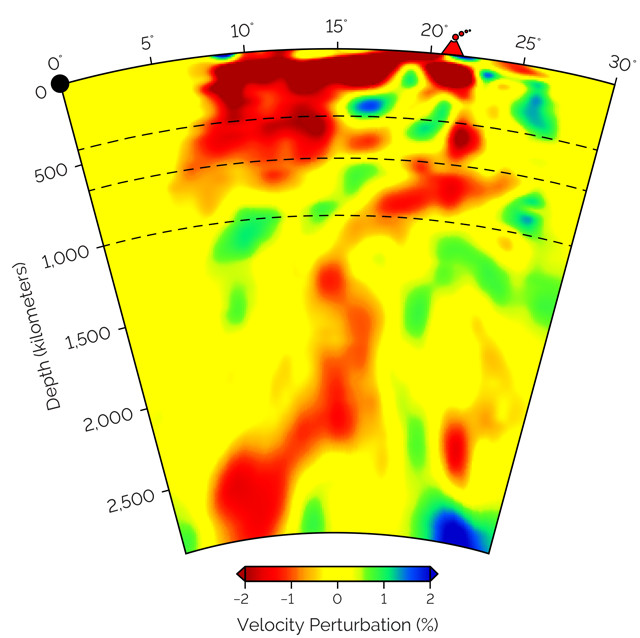
by Mary Caperton Morton Tuesday, June 5, 2018

Yellowstone's many thermal features are fueled by a deep mantle plume rooted at the core-mantle boundary under Mexico. Credit: Nelson et al., Nature Geoscience, 2018.
The volcanic activity at Yellowstone National Park is impressive, with thousands of active thermal features dotting a nearly 4,000-square-kilometer caldera. Scientists have long suspected that a massive mantle plume underlies the supervolcano. Now, new imaging has provided the clearest picture yet of the heat source that drives Yellowstone’s volcanism.
The existence of mantle plumes under volcanic hot spots such as Yellowstone, Iceland and Hawaii continues to be debated among geologists, with detractors pointing to a lack of concrete geophysical evidence for the hot upwellings arising from deep in the mantle. Imaging Earth’s interior is usually accomplished by tracking seismic wave velocities as they move through the crust and mantle — a technique called seismic tomography — but, so far, clear examples of mantle plumes haven’t been seen in such imaging.
“Seismic waves travel faster through cold rocks than hot rocks, so if you have something really hot like a large mantle plume, you expect it to slow the waves,” says Peter Nelson, a geophysicist at the University of Texas (UT) at Austin and a co-author of the new study in Nature Geoscience. But the type of seismic waves most commonly used in tomography studies — called surface waves, or S-waves — is only slightly slowed by plumes because of the respective orientations of the waves and plumes: S-waves mostly travel horizontally through the mantle and are not slowed down much by vertically oriented mantle plumes, Nelson says.
So, Nelson and co-author Stephen Grand, also at UT-Austin, turned to two other kinds of earthquake waves, called SKS and SKKS waves. (S stands for shear, K for compressional.) “These waves travel more vertically [through the mantle], so they will traverse a plume for a much greater distance than S-waves,” thus revealing a lot more about the plume’s structure, Nelson says.
Yellowstone is an ideal setting for this kind of study because it’s located in the middle of a continent, where a dense seismic network, EarthScope’s USArray, has been deployed in recent years. Drawing upon seismic data gathered from 71 earthquakes over a period of 48 months, Nelson and Grand identified a vertically elongated zone of the Earth’s mantle where the SKS and SKKS waves traveled more slowly. This 400-kilometer-wide zone appears to be rooted at the core-mantle boundary beneath Mexico, running to the northeast beneath the western U.S. to Yellowstone as it rises through the mantle.
The position of the plume’s base south of the California-Mexico border came as a surprise, Nelson says, although previously published models had predicted that the prevailing convective currents of the mantle likely meant the Yellowstone plume would have its roots somewhere southwest of the park. “Why plumes form where they do is an open question. We found a much larger tilt (from southwest to northeast) than expected, but it aligns with what the models have predicted,” Nelson says.
The study provides the best look yet at Yellowstone’s mantle plume and foreshadows the scope of future work that will be possible with data from the USArray, says Barbara Romanowicz, a planetary seismologist at the University of California at Berkeley, who was not involved in the new study. Instead of focusing on just the S-wave part of earthquake seismograms, “the way of the future is to use the whole seismogram and the whole wave form to study the interior of the planet,” she says.
This kind of work requires high-resolution datasets that can only be produced using dense seismic networks, such as the USArray. “Yellowstone presents a unique opportunity to image a plume under a continent. There’s probably a plume under Hawaii, and another under Iceland, but we don’t have the seismic coverage [from seafloor instruments] to image those,” Romanowicz says. Plumes may also exist under Africa and Antarctica, but, again, the seismic detection coverage isn’t adequate to produce the high-resolution data needed to image plumes in those locations, she says.
“At this point, I think we can say that the existence of mantle plumes is well established,” Romanowicz says. “Now let’s focus our efforts on addressing critical questions like: How wide are they? Do they have thermal boundaries, or are they thermochemical? Using the USArray to study Yellowstone, the possibilities are really endless.”
© 2008-2021. All rights reserved. Any copying, redistribution or retransmission of any of the contents of this service without the expressed written permission of the American Geosciences Institute is expressly prohibited. Click here for all copyright requests.